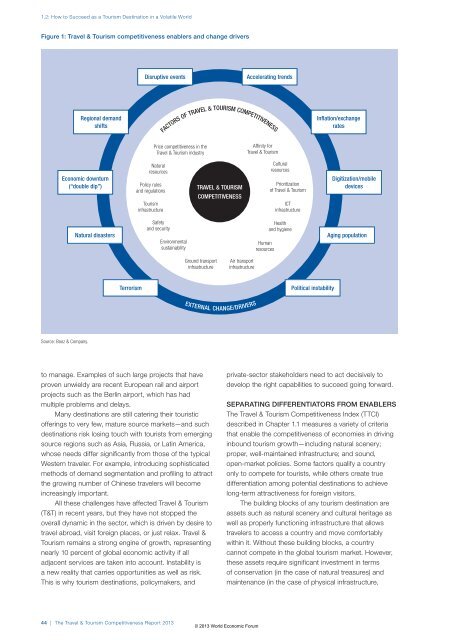The Travel & Tourism Competitiveness Report 2013
The Travel & Tourism Competitiveness Report 2013
The Travel & Tourism Competitiveness Report 2013
Create successful ePaper yourself
Turn your PDF publications into a flip-book with our unique Google optimized e-Paper software.
1.2: How to Succeed as a <strong>Tourism</strong> Destination in a Volatile World<br />
Figure 1: <strong>Travel</strong> & <strong>Tourism</strong> competitiveness enablers and change drivers<br />
Source: Booz & Company.<br />
Regional demand<br />
shifts<br />
Economic downturn<br />
(“double dip”)<br />
Natural disasters<br />
Terrorism<br />
Disruptive events<br />
Natural<br />
resources<br />
Policy rules<br />
and regulations<br />
<strong>Tourism</strong><br />
infrastructure<br />
Safety<br />
and security<br />
to manage. Examples of such large projects that have<br />
proven unwieldy are recent European rail and airport<br />
projects such as the Berlin airport, which has had<br />
multiple problems and delays.<br />
Many destinations are still catering their touristic<br />
offerings to very few, mature source markets—and such<br />
destinations risk losing touch with tourists from emerging<br />
source regions such as Asia, Russia, or Latin America,<br />
whose needs differ significantly from those of the typical<br />
Western traveler. For example, introducing sophisticated<br />
methods of demand segmentation and profiling to attract<br />
the growing number of Chinese travelers will become<br />
increasingly important.<br />
All these challenges have affected <strong>Travel</strong> & <strong>Tourism</strong><br />
(T&T) in recent years, but they have not stopped the<br />
overall dynamic in the sector, which is driven by desire to<br />
travel abroad, visit foreign places, or just relax. <strong>Travel</strong> &<br />
<strong>Tourism</strong> remains a strong engine of growth, representing<br />
nearly 10 percent of global economic activity if all<br />
adjacent services are taken into account. Instability is<br />
a new reality that carries opportunities as well as risk.<br />
This is why tourism destinations, policymakers, and<br />
44 | <strong>The</strong> <strong>Travel</strong> & <strong>Tourism</strong> <strong>Competitiveness</strong> <strong>Report</strong> <strong>2013</strong><br />
FACTORS OF TRAVEL & TOURISM COMPETITIVENESS<br />
Price competitiveness in the<br />
<strong>Travel</strong> & <strong>Tourism</strong> industry<br />
Environmental<br />
sustainability<br />
TRAVEL & TOURISM<br />
COMPETITIVENESS<br />
Ground transport<br />
infrastructure<br />
Air transport<br />
infrastructure<br />
EXTERNAL CHANGE/DRIVERS<br />
Accelerating trends<br />
Affinity for<br />
<strong>Travel</strong> & <strong>Tourism</strong><br />
Human<br />
resources<br />
Cultural<br />
resources<br />
Prioritization<br />
of <strong>Travel</strong> & <strong>Tourism</strong><br />
ICT<br />
infrastructure<br />
Health<br />
and hygiene<br />
Political instability<br />
Inflation/exchange<br />
rates<br />
Digitization/mobile<br />
devices<br />
Aging population<br />
private-sector stakeholders need to act decisively to<br />
develop the right capabilities to succeed going forward.<br />
SEPARATING DIFFERENTIATORS FROM ENABLERS<br />
<strong>The</strong> <strong>Travel</strong> & <strong>Tourism</strong> <strong>Competitiveness</strong> Index (TTCI)<br />
described in Chapter 1.1 measures a variety of criteria<br />
that enable the competitiveness of economies in driving<br />
inbound tourism growth—including natural scenery;<br />
proper, well-maintained infrastructure; and sound,<br />
open-market policies. Some factors qualify a country<br />
only to compete for tourists, while others create true<br />
differentiation among potential destinations to achieve<br />
long-term attractiveness for foreign visitors.<br />
<strong>The</strong> building blocks of any tourism destination are<br />
assets such as natural scenery and cultural heritage as<br />
well as properly functioning infrastructure that allows<br />
travelers to access a country and move comfortably<br />
within it. Without these building blocks, a country<br />
cannot compete in the global tourism market. However,<br />
these assets require significant investment in terms<br />
of conservation (in the case of natural treasures) and<br />
maintenance (in the case of physical infrastructure,<br />
© <strong>2013</strong> World Economic Forum

















